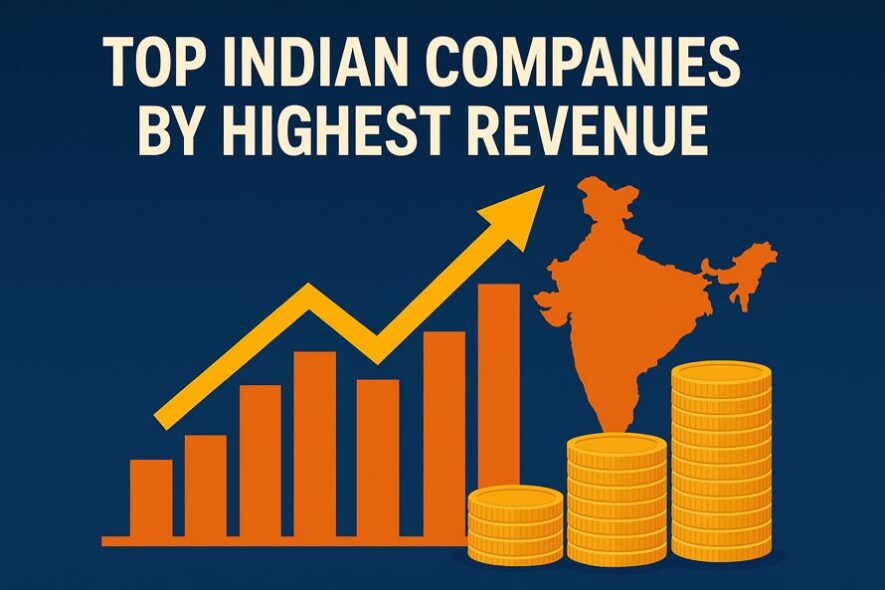
Introduction to India’s Corporate Giants
High-revenue companies hold a steady grip in India’s business landscape. They drive large-scale transactions, bring in consistent cash flow, and support critical sectors like energy, banking, infrastructure, and tech. These firms often take the lead on capital projects, industry partnerships, and market growth.
They keep supply chains active, create stable employment, and push investment activity across regions. Their numbers reflect how business moves on the ground—measured through contracts, customers, and actual delivery. Let’s discuss why these companies matter.
Economic Significance of High-Revenue Companies
Big companies move the economy. In India, corporate giants shape job markets, supply chains, exports, and even global investor sentiment. These companies invest capital into infrastructure, research, and logistics. Their scale makes them magnets for international partnerships and homegrown innovation. As their top line grows, their tax contributions and regional economic footprints expand too.
In a growing economy like India’s, high-revenue companies also act as market stabilizers. They have long-term projects, invest across business cycles, and set the pace in every major sector, from energy to tech. When these giants perform, entire industries get a push.
How Revenue Rankings Are Determined
We have prepared this list after a thorough market analysis. We have analyzed gross annual revenue from company filings, regulatory disclosures, and audited annual reports.
For every publicly listed firm, it’s mandatory to report its revenue through the Bombay Stock Exchange (BSE), National Stock Exchange (NSE), and the Ministry of Corporate Affairs. Private giants also release revenue details to meet compliance or investor transparency goals.
Analysts track total sales, excluding taxes, but including operational and non-operational income. Rankings focus purely on revenue, not profits. That’s why some firms with razor-thin margins still lead the revenue charts. It’s about total business volume, not just bottom lines.
Top 10 Highest Revenue Companies in India (2025)
India’s corporate titans dominate sectors like energy, banking, telecom, and IT. Here’s the updated 2025 leaderboard (₹ crore figures):
| Rank | Company Name | Revenue (As of March 2025) | Sector |
|---|---|---|---|
| 1 | Reliance Industries Ltd | ₹982,671 Cr | Energy, Retail, Telecom |
| 2 | State Bank of India | ₹835,748.85 Cr | Banking & Finance |
| 3 | Indian Oil Corp. | ₹761,619.54 Cr | Oil & Gas |
| 4 | HDFC Bank | ₹605,464.43 Cr | Banking |
| 5 | Tata Motors | ₹445,939 Cr | Automotive |
| 6 | Bharath Petroleum | ₹442,956.58 Cr | Oil & Gas |
| 7 | Hindustan Petroleum | ₹436,194.02 Cr | Oil & Gas |
| 8 | Larsen & Toubro | ₹259,859.27 Cr | Infrastructure |
| 9 | Tata Consultancy Services | ₹259,286 Cr | IT Services |
| 10 | Infosys | ₹166,590 Cr | IT Services |
Source: Lemonn
Reliance takes the top spot with its aggressive expansion across digital, energy, retail, and telecom. Oil companies remain steady performers due to global energy demand and consistent domestic consumption. Banks and IT firms fill out the list, reflecting India’s dual engine: capital and code.
Sector-Wise Breakdown of Top Revenue Companies
Revenue champions sit across five key industries. These sectors handle large-scale demand, high transaction volumes, and nationwide reach. That’s what pushes their revenue charts higher year after year.
Let’s break it down:
- Energy & Oil: Reliance, Indian Oil, BPCL, HPCL
- Banking & Finance: SBI, HDFC Bank
- Automotive: Tata Motors
- IT Services: TCS, Infosys
- Engineering & Infra: Larsen & Toubro
The energy and oil sector takes the lead. These companies deal in volume, fuel, gas, and petrochemicals that move across the country daily. Public sector firms like Indian Oil, Bharat Petroleum, and Hindustan Petroleum handle nationwide distribution, refinery operations, and strategic reserves. Their role in national energy security locks in consistent demand. In the private sector, Reliance brings a different playbook. It integrates exploration, refining, retail, and digital energy solutions, keeping the money flowing from every touchpoint.
The banking sector follows closely. SBI and HDFC Bank garner revenue from personal banking, enterprise lending, wealth services, and digital platforms. SBI has a pan-India network that spans the nook and corner of the country, while HDFC Bank is also expanding fast into small towns. With India’s financial inclusion mission in full swing, these banks see new customers every day, providing banking services to every Indian.
Tata Motors represents the thriving automotive sector. It fuels revenue through commercial vehicles, electric cars, and global exports through its marquee Jaguar Land Rover brand. Demand spikes in logistics, infrastructure, and urban transport all feed its sales engine.
The IT sector doesn’t lag either. TCS and Infosys serve Fortune 500 clients in cloud, AI, cybersecurity, and enterprise software. Their global delivery model lets them earn across time zones.
L&T, the builder, is among the top revenue-earning firms. Building roads, airports, and metro systems, its order book drives steady, capital-rich revenue year after year.
Each of these sectors tells the same story: scale, demand, and delivery keep the revenue wheel turning.
Revenue Comparison with Global Peers
How Indian Giants Stack Against Global Corporations
India’s top companies make waves, but global giants still sit a few tiers higher in total revenue. For context:
| Company | Country | 202 Revenue (Est.) |
|---|---|---|
| Walmart | USA | $708 Billion |
| Amazon | USA | $670 Billion |
| Saudi Aramco | Saudi Arabia | $461 Billion |
| Reliance Industries | India | $125.3 Billion |
| State Bank of India | India | $42 Billion |
Source: Macrotrends, Companies Market Cap
Indian giants hold their own, especially when adjusted for purchasing power and labor cost. Reliance’s revenue beats many global oil and retail players. SBI ranks among the largest global banks in terms of customer base and branch network.
Trends in Emerging Market Revenues
India’s story is a replication of a broader trend. It’s a story of rising giants in emerging markets. Companies in countries like Brazil, Indonesia, Vietnam, and South Africa also follow a similar pattern. They are growing fast, tapping into large domestic populations and digital-first markets.
But India holds a unique edge. And what makes it unique is the perfect mix of consumption-driven growth. India has a thriving private sector, and global tech services are lining up to have their presence in India. Moreover, the young demographics are the country’s biggest strength as they spur consumption.
Key Trends Influencing Revenue Growth in India
Government Policies and Reforms
Growth doesn’t just happen. It gets a push from smart policies and serious capital investments. Over the past few years, reforms have helped. GST cleaned up the confusing maze of indirect taxes. Corporate tax cuts brought relief to big businesses. And Production Linked Incentive (PLI) schemes started pouring fresh investment into key sectors.
Roads, ports, airports, and power grids all got massive upgrades. That means goods move quickly, projects finish faster, and companies earn more. Manufacturing got a fresh shot from campaigns like Make in India and Atmanirbhar Bharat. More sourcing is now happening within the country, which means larger order books for local giants.
Defense, chip-making, and clean tech saw big government spending. Firms like Tata, Adani, and L&T jumped in and locked long-term contracts. Disinvestments opened fresh lanes, too. Private firms picked up stakes in public assets and turned them into revenue machines. It’s not just policy on paper, it’s revenue in accounts.
Digital Transformation and Tech Integration
Top companies don’t just run factories anymore. They run code. Reliance Jio laid down a national 5G base. SBI rolled out AI-backed banking tools. Everyone’s racing to digitize, and it’s paying off.
Cloud adoption now cuts costs and speeds up execution. AI, bots, and smart analytics handle fraud checks, predict maintenance issues, and personalize customer journeys. Traditional sectors use digital twins and IoT sensors to run smart factories and supply chains.
Revenue climbs faster when you remove lags. And that’s exactly what these tech shifts deliver: speed, precision, and scale without needing to double headcount or square footage.
Expansion into Global Markets
India Inc. plays global now, and plays big. For instance, TCS, Infosys, and Wipro count some of the leading US-based multinationals among their clients. Tata Motors is a global brand, thanks to its Jaguar Land Rover brand. Furthermore, the likes of Adani Group bag ports, power, and infra deals across Asia and Africa.
These cross-border plays bring in foreign revenue, boost deal flow, and unlock global customers. Plus, they force Indian companies to operate at international benchmarks. That improves systems at home, too.
Mergers and acquisitions are growing fast. Indian firms acquire mid-size players in Southeast Asia, Europe, and the Gulf to enter new regions fast. These aren’t one-off wins; global expansion is now a serious revenue engine.
Conclusion
India’s top revenue companies show that India is ambitious. These firms operate in various sectors that are crucial to the nation’s growth and development. Some of them cater to the routine needs of citizens, like electricity and fuel, banking, telecom, and tech. Their rising revenue signals India’s increasing economic muscle on the world stage.
As the 2025 charts show, private innovation and public infrastructure combine to drive scale. Energy still dominates, but tech, finance, and infra are catching up fast. These companies are building more than revenue. They’re shaping the economy’s next chapter.
And this is just the beginning. More reforms are coming in, and the global partnerships are soaring. This will make India a powerhouse and a strong regional power in the very near future. More tech upgrades are coming in, and more global partnerships are taking shape. It’s time to invest in India and India’s growth story.
FAQs:
Q. Which Indian company has the highest revenue in 2025?
Reliance Industries Ltd holds the top spot, as of March 2025. Its diversified presence across energy, retail, telecom, and digital services drives strong topline numbers year after year.
Q. What are the major sectors contributing to high corporate revenues in India?
The big revenue generators in India include companies operating in energy and oil, banking and finance, automotive, information technology, infrastructure, and construction. These sectors handle large-scale demand and have consistent capital flow, which fuels their growth.
Q. How is company revenue calculated for ranking purposes?
Revenue is calculated as the total income earned by a company from its core operations. Analysts use gross annual sales, excluding taxes, but including both operational and non-operational income. Audited reports, regulatory filings, and disclosures to stock exchanges form the basis for ranking.
Q. Are there any startups entering the high-revenue category in India?
Some late-stage startups and unicorns have started entering the ₹1,000–₹5,000 crore annual revenue range. Sectors like fintech, logistics, and D2C brands are pushing harder toward the mainstream.
Q. Which public sector companies are among the top revenue earners in India?
Public sector giants like Indian Oil Corporation, State Bank of India, Bharat Petroleum, and Hindustan Petroleum rank high on the revenue charts. Their scale, national reach, and steady government-linked demand drive consistent topline growth.
Q. How does Reliance Industries maintain its top position in revenue?
Reliance operates across critical sectors—oil refining, petrochemicals, telecom, retail, and green energy. Its integrated business model, aggressive expansion, and digital strategy help it generate large volumes and scale operations quickly.
Q. What is the difference between revenue and profit for these companies?
Revenue is the total money a company earns from selling its products or services. Profit is what remains after deducting all costs, taxes, and expenses from that revenue. High revenue shows business volume, while profit reflects efficiency and margin strength.







